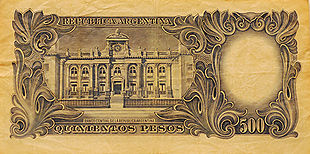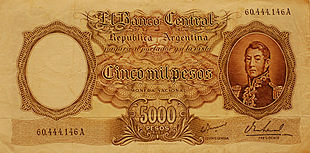Argentine peso moneda nacional
This article includes a list of references, related reading, or external links, but its sources remain unclear because it lacks inline citations. (January 2016) |
| peso moneda nacional argentino (Spanish) | |
|---|---|
| ISO 4217 | |
| Unit | |
| Symbol | m$n or $m/n |
| Denominations | |
| Superunit | |
| 5 | argentino |
| Subunit | |
| 1/100 | centavo |
| Symbol | |
| centavo | ¢ |
| Banknotes | 50 centavos, 1, 5, 10, 50, 100, 500, 1000, 5000, 10 000 pesos |
| Coins | 1, 2, 5, 10, 20, 50 centavos, 1, 5, 10, 25 pesos |
| Demographics | |
| User(s) | Argentina |
| Issuance | |
| Central bank | Banco Central de la República Argentina |
| Website | www |
The peso moneda nacional was the currency of Argentina from November 5, 1881 to January 1, 1970, the date in which the Argentine peso ley was issued to the Argentine public. It was subdivided into 100 centavos, with the argentino worth 5 pesos. Its symbol was m$n or $m/n. Its ISO 4217 code was ARM.
History
The peso moneda nacional replaced the Argentine real at a rate of one to eight. It also replaced the peso fuerte at par and the peso moneda corriente at a rate of 25 pesos monedas corrientes = 1 peso moneda nacional. The peso moneda nacional was itself replaced by the peso ley at a rate of one hundred to one.
The peso was initially pegged to the French franc at a rate of 1 peso = 5 francs. In 1883, when silver coins ceased production, the paper peso was set at a value of 2.2 francs or 638.7 mg gold. After a suspension in the gold standard from 1914, in 1927, a peg to the U.S. dollar was established of 2.36 pesos = 1 dollar. The rate changed to 1.71 pesos = 1 dollar in 1931, then to 3 pesos = 1 dollar in 1933. Between 1934 and 1939, the peso was pegged to the British pound at a rate of 15 pesos = 1 pound. High inflation in the post-war period lead to the introduction of the peso ley in 1970 at the rate of 100 pesos monedas nacionales = 1 peso ley.
Coins
In 1881, silver 10, 20 and 50 centavos and 1 peso and gold 1 argentino coins were introduced, followed by bronze 1 and 2 centavos the next year. Silver coins ceased production in 1883, with gold coins ending in 1896. Base metal 5, 10 and 20 centavos were introduced in 1896, with base 50 centavos following in 1941. The 1 peso was reintroduced in 1957, with 5, 10 and 25 pesos introduced in 1961, 1962 and 1964.
Centavo
| Value | Obverse | Emission | Withdrawn | Composition | Diameter |
|---|---|---|---|---|---|
| 1 | Liberty | 1882 - 1896 | 21 April 1959 | Bronze | 25 mm |
| 1 | Coat of arms | 1939 - 1944 | 21 April 1959 | Bronze | 16 mm |
| 1 | Coat of arms | 1945 - 1948 | 21 April 1959 | Copper | 16 mm |
| 2 | Liberty | 1882 - 1896 | 21 April 1959 | Bronze | 30 mm |
| 2 | Coat of arms | 1939 - 1947 | 21 April 1959 | Bronze | 20 mm |
| 2 | Coat of arms | 1947 - 1950 | 21 April 1959 | Copper | 20 mm |
| 5 | Liberty | 1896 - 1942 | 31 January 1965 | Copper-Nickel | 17 mm |
| 5 | Liberty | 1942 - 1950 | 31 January 1965 | Aluminium-Bronze | 17 mm |
| 5 | José de San Martín | 1950 - 1953 | 31 January 1965 | Copper-Nickel | 17 mm |
| 5 | José de San Martín | 1953 - 1956 | 31 January 1965 | Copper-Nickel clad steel | 17 mm |
| 5 | Liberty | 1957 - 1959 | 31 January 1965 | Copper-Nickel clad steel | 17 mm |
| 10 | Liberty | 1881 - 1883 | .900 Silver | 18 mm | |
| 10 | Liberty | 1896 - 1942 | 21 January 1966 | Copper-Nickel | 19 mm |
| 10 | Liberty | 1942 - 1950 | 21 January 1966 | Aluminium-Bronze | 19 mm |
| 10 | José de San Martín | 1950 - 1952 | 21 January 1966 | Copper-Nickel | 19 mm |
| 10 | José de San Martín | 1952 - 1956 | 21 January 1966 | Nickel clad steel | 19 mm |
| 10 | Liberty | 1957 - 1959 | 21 January 1966 | Nickel clad steel | 19 mm |
| 20 | Liberty | 1881 - 1883 | .900 Silver | 22 mm | |
| 20 | Liberty | 1896 - 1942 | 31 January 1967 | Copper-Nickel | 21 mm |
| 20 | Liberty | 1942 - 1950 | 31 January 1967 | Aluminium-Bronze | 21 mm |
| 20 | José de San Martín | 1950 - 1952 | 31 January 1967 | Copper-Nickel | 21 mm |
| 20 | José de San Martín | 1952 - 1956 | 31 January 1967 | Nickel clad steel | 21 mm |
| 20 | Liberty | 1957 - 1961 | 31 January 1967 | Nickel clad steel | 21 mm |
| 50 | Liberty | 1881 - 1883 | .900 Silver | 29 mm | |
| 50 | Liberty | 1941 | 31 January 1969 | Nickel | 24 mm |
| 50 | José de San Martín | 1952 - 1956 | 31 January 1969 | Nickel clad steel | 23 mm |
| 50 | Liberty | 1957 - 1961 | 31 January 1969 | Nickel clad steel | 23 mm |
Peso
| Value | Obverse | Emission | Withdrawn | Composition | Diameter |
|---|---|---|---|---|---|
| 1 | Liberty | 1881 - 1883 | .900 Silver | 39 mm | |
| 1 | Liberty | 1957 - 1962 | 1 October 1974 | Nickel clad steel | 25 mm |
| 1 | Buenos Aires Cabildo | 1960 | 1 October 1974 | Nickel clad steel | 25 mm |
| 5 | Liberty | 1881 - 1896 | .900 Gold | 23 mm | |
| 5 | President Sarmiento frigate | 1961 - 1968 | 12 April 1976 | Nickel clad steel | 21 mm |
| 10 | Gaucho riding horse | 1962 - 1968 | 12 July 1976 | Nickel clad steel | 21 mm |
| 10 | House of Tucumán | 1966 | 12 July 1976 | Nickel clad steel | 21 mm |
| 25 | First national coin | 1964 - 1968 | 12 July 1976 | Nickel clad steel | 26 mm |
| 25 | Domingo Faustino Sarmiento | 1968 | 12 July 1976 | Nickel clad steel | 26 mm |
Banknotes




The first nationally issued banknotes were introduced by the Banco Nacional in 1884. These were in denominations of 5, 10, 20 and 50 centavos. In 1891 and 1892, the same denominations were produced by the Banco de la Nación Argentina. In 1894, the Banco de la Nación Argentina introduced larger denomination notes for 1, 2, 5, 10, 20, 50, 100, 200, 500 and 1000 pesos.
Paper money production was taken over by the Caja de Conversion in 1899. That year, 50 centavos, 1 and 100 pesos were introduced, followed in 1900 by notes for 5, 10, 50, 500 and 1000 pesos. These notes were issued until 1935, when the Banco Central began to produce notes.
Issues 1899-1935
Law 3505, of 20 September, 1897, authorized the Caja de Conversión to renovate all paper money in existence at the time. They decided to make new design called "Progress's Effigy" ("Efigie del Progreso").
These bank notes were created originally in a bigger size and printed by the mint (Casa de Moneda), using French-made paper. Due to their size, and the paper not being of good enough quality, they began to deteriorate. They then decided to suspend the printing and look for another provider. The new notes, of smaller size, started to be issued in 1903, using typography as the printing method.
The Banco Central issued the following banknotes:
| Value | Portrait | Back | Emission start date | Withdrawn | Image |
|---|---|---|---|---|---|
| 50 centavos | Republic face | National Constitution | 1942 | 31 December 1960 | 
|
| 1 | Justice | House of Tucumán | 1935 | 31 December 1960 | 
|
| 5 | José de San Martín | May Revolution | 1935 | 31 January 1965 | 
|
| 10 | José de San Martín | Oath of Independence | 17 March 1936 | 31 January 1965 | 
|
| 50 | José de San Martín | Passage of the Andes | 10 September 1936 | 30 March 1968 | 
|
| 50 | José de San Martín | Passage of the Andes | 2 January 1943 | 30 September 1968 |  
|
| 100 | José de San Martín | Buenos Aires foundation | 14 August 1936 | 30 March 1968 | 
|
| 100 | José de San Martín | Buenos Aires foundation | 23 December 1943 | 30 September 1968 |  
|
| 500 | José de San Martín | Argentine Central Bank | 21 December 1944 | 30 March 1968 |  
|
| 500 | José de San Martín | San Martín's house at Grand Bourg | 25 November 1964 | 30 September 1968 | 
|
| 1,000 | José de San Martín | President Sarmiento Frigate | 21 December 1944 | 1 July 1975 |  
|
| 5,000 | José de San Martín | National Congress | 4 October 1962 | 1 July 1975 |  
|
| 10,000 | José de San Martín | San Martín and O'Higgins meeting | 18 December 1961 | 1 July 1975 |
References
- Krause, Chester L.; Clifford Mishler (1991). Standard Catalog of World Coins: 1801–1991 (18th ed.). Krause Publications. ISBN 0873411501.
- Pick, Albert (1994). Bruce, Colin R. II; Shafer, Neil (eds.). Standard Catalog of World Paper Money: General Issues (7th ed.). Krause Publications. ISBN 0-87341-207-9.
- Silveyra, Jorge; Lozano, Sergio; Díaz, Oscar (2001). Falsificación de moneda. Editorial Policial. ISBN 950-9071-66-8.








